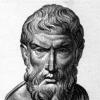Electronic formula nb. Electronic formulas. Distribution of electrons using the periodic system of D. I. Mendeleev
Let's find out how to create the electronic formula of a chemical element. This question is important and relevant, as it gives an idea not only of the structure, but also of the expected physical and chemical properties of the atom in question.
Compilation rules
In order to compose a graphical and electronic formula of a chemical element, it is necessary to have an understanding of the theory of atomic structure. To begin with, there are two main components of an atom: the nucleus and the negative electrons. The nucleus includes neutrons, which have no charge, as well as protons, which have a positive charge.
Discussing how to compose and determine the electronic formula of a chemical element, we note that to find the number of protons in the nucleus, the Mendeleev periodic system will be required.
The number of an element corresponds in order to the number of protons found in its nucleus. The number of the period in which the atom is located characterizes the number of energy layers on which electrons are located.
To determine the number of neutrons devoid of electrical charge, it is necessary to subtract its serial number (number of protons) from the relative mass of an element’s atom.
Instructions
In order to understand how to compose the electronic formula of a chemical element, consider the rule for filling sublevels with negative particles, formulated by Klechkovsky.
Depending on how much free energy the free orbitals have, a series is compiled that characterizes the sequence of filling levels with electrons.
Each orbital contains only two electrons, which are arranged in antiparallel spins.
In order to express the structure of electronic shells, graphic formulas are used. What do the electronic formulas of atoms of chemical elements look like? How to create graphic options? These questions are included in the school chemistry course, so we will dwell on them in more detail.
There is a certain matrix (basis) that is used when drawing up graphic formulas. The s-orbital is characterized by only one quantum cell, in which two electrons are located opposite each other. They are indicated graphically by arrows. For the p-orbital, three cells are depicted, each also containing two electrons, the d orbital contains ten electrons, and the f orbital is filled with fourteen electrons.

Examples of compiling electronic formulas
Let's continue the conversation about how to compose the electronic formula of a chemical element. For example, you need to create a graphical and electronic formula for the element manganese. First, let's determine the position of this element in the periodic table. It has atomic number 25, therefore, there are 25 electrons in the atom. Manganese is a fourth period element and therefore has four energy levels.
How to write the electronic formula of a chemical element? We write down the sign of the element, as well as its serial number. Using Klechkovsky's rule, we distribute electrons among energy levels and sublevels. We place them sequentially on the first, second, and third levels, placing two electrons in each cell.
Next, we sum them up, getting 20 pieces. Three levels are completely filled with electrons, and only five electrons remain on the fourth. Considering that each type of orbital has its own energy reserve, we distribute the remaining electrons into the 4s and 3d sublevels. As a result, the finished electronic graphic formula for the manganese atom has the following form:
1s2 / 2s2, 2p6 / 3s2, 3p6 / 4s2, 3d3

Practical significance
Using electron graphic formulas, you can clearly see the number of free (unpaired) electrons that determine the valence of a given chemical element.
We offer a generalized algorithm of actions with which you can create electron graphic formulas for any atoms located in the periodic table.
First of all, it is necessary to determine the number of electrons using the periodic table. The period number indicates the number of energy levels.
Belonging to a certain group is associated with the number of electrons located in the outer energy level. The levels are divided into sublevels and filled in taking into account the Klechkovsky rule.

Conclusion
In order to determine the valence possibilities of any chemical element located in the periodic table, it is necessary to compile an electronic graphic formula of its atom. The algorithm given above will allow us to cope with the task and determine the possible chemical and physical properties of the atom.
- First we write down the chemical sign. element, where at the bottom left of the sign we indicate its serial number.
- Next, by the number of the period (from which the element) we determine the number of energy levels and draw such a number of arcs next to the sign of the chemical element.
- Then, according to the group number, the number of electrons in the outer level is written under the arc.
- At the 1st level, the maximum possible is 2, at the second there are already 8, at the third – as many as 18. We begin to put numbers under the corresponding arcs.
- The number of electrons at the penultimate level must be calculated as follows: the number of electrons already assigned is subtracted from the element’s serial number.
- It remains to turn our diagram into an electronic formula:
- We write the chemical element and its serial number. The number shows the number of electrons in the atom.
- Let's make a formula. To do this, you need to find out the number of energy levels; the basis for the determination is the period number of the element.
- We divide the levels into sub-levels.
Below you can see an example of how to correctly compose electronic formulas of chemical elements.
- first we fill the s-sublevel, and then the p-, d- b f-sublevels;
- according to Klechkovsky's rule, electrons fill orbitals in order of increasing energy of these orbitals;
- according to Hund's rule, electrons within one sublevel occupy free orbitals one at a time and then form pairs;
- According to the Pauli principle, there are no more than 2 electrons in one orbital.
The electronic formula of a chemical element shows how many electron layers and how many electrons are contained in the atom and how they are distributed among the layers.
To compose the electronic formula of a chemical element, you need to look at the periodic table and use the information obtained for this element. The atomic number of an element in the periodic table corresponds to the number of electrons in an atom. The number of electronic layers corresponds to the period number, the number of electrons in the last electronic layer corresponds to the group number.
It must be remembered that the first layer contains a maximum of 2 electrons 1s2, the second - a maximum of 8 (two s and six p: 2s2 2p6), the third - a maximum of 18 (two s, six p, and ten d: 3s2 3p6 3d10).
For example, the electronic formula of carbon: C 1s2 2s2 2p2 (serial number 6, period number 2, group number 4).
Electronic formula for sodium: Na 1s2 2s2 2p6 3s1 (serial number 11, period number 3, group number 1).
To check whether the electronic formula is written correctly, you can look at the website www.alhimikov.net.
At first glance, compiling an electronic formula for chemical elements may seem like a rather complicated task, but everything will become clear if you adhere to the following scheme:
- first we write the orbitals
- We insert numbers in front of the orbitals that indicate the number of the energy level. Don't forget the formula for determining the maximum number of electrons at the energy level: N=2n2
How can you find out the number of energy levels? Just look at the periodic table: this number is equal to the number of the period in which the element is located.
- Above the orbital icon we write a number that indicates the number of electrons that are in this orbital.
For example, the electronic formula for scandium will look like this.
The task of compiling an electronic formula for a chemical element is not the easiest.
So, the algorithm for compiling electronic formulas of elements is as follows:
Here are the electronic formulas of some chemical elements:
You need to create electronic formulas of chemical elements in this way: you need to look at the number of the element in the periodic table, thus finding out how many electrons it has. Then you need to find out the number of levels, which is equal to the period. Then the sublevels are written and filled in:
First of all, you need to determine the number of atoms according to the periodic table.

To compose the electronic formula, you will need the periodic system of Mendeleev. Find your chemical element there and look at the period - it will be equal to the number of energy levels. The group number will correspond numerically to the number of electrons in the last level. The number of an element will be quantitatively equal to the number of its electrons. You also clearly need to know that the first level has a maximum of 2 electrons, the second - 8, and the third - 18.
These are the main points. In addition, on the Internet (including our website) you can find information with a ready-made electronic formula for each element, so you can test yourself.
Compiling electronic formulas of chemical elements is a very complex process; you can’t do it without special tables, and you need to use a whole bunch of formulas. Briefly, to compile you need to go through these stages:
It is necessary to draw up an orbital diagram in which there will be a concept of how electrons differ from each other. The diagram highlights orbitals and electrons.
Electrons are filled in levels, from bottom to top, and have several sublevels.
So first we find out the total number of electrons of a given atom.
We fill out the formula according to a certain scheme and write it down - this will be the electronic formula.

For example, for Nitrogen this formula looks like this, first we deal with electrons:

And write down the formula:

To understand the principle of compiling the electronic formula of a chemical element, first you need to determine the total number of electrons in an atom by the number in the periodic table. After this, you need to determine the number of energy levels, taking as a basis the number of the period in which the element is located.
The levels are then broken down into sublevels, which are filled with electrons based on the Principle of Least Energy.
You can check the correctness of your reasoning by looking, for example, here.
By composing the electronic formula of a chemical element, you can find out how many electrons and electron layers are in a particular atom, as well as the order of their distribution among the layers.
First, we determine the atomic number of the element according to the periodic table; it corresponds to the number of electrons. The number of electron layers indicates the period number, and the number of electrons in the last layer of the atom corresponds to the group number.
Ether in the periodic table
The world ether is the substance of EVERY chemical element and, therefore, EVERY substance; it is the Absolute true matter as the Universal element-forming Essence.The world ether is the source and crown of the entire genuine Periodic Table, its beginning and end - the alpha and omega of the Periodic Table of Elements of Dmitry Ivanovich Mendeleev.
In ancient philosophy, ether (aithér-Greek), along with earth, water, air and fire, is one of the five elements of being (according to Aristotle) - the fifth essence (quinta essentia - Latin), understood as the finest all-pervading matter. At the end of the 19th century, the hypothesis of a world ether (ME) filling all of the world’s space became widely circulated in scientific circles. It was understood as a weightless and elastic liquid that permeates all bodies. They tried to explain many physical phenomena and properties by the existence of the ether.
Preface.
Mendeleev had two fundamental scientific discoveries:
1 - Discovery of the Periodic Law in the substance of chemistry,
2 - Discovery of the relationship between the substance of chemistry and the substance of Ether, namely: particles of Ether form molecules, nuclei, electrons, etc., but do not participate in chemical reactions.
Ether is particles of matter ~ 10-100 meters in size (in fact, they are the “first bricks” of matter).
Data. Ether was in the original periodic table. The cell for Ether was located in the zero group with inert gases and in the zero row as the main system-forming factor for building the System of chemical elements. After Mendeleev's death, the table was distorted by removing Ether from it and eliminating the zero group, thereby hiding the fundamental discovery of conceptual significance.
In modern Ether tables: 1 - not visible, 2 - not guessable (due to the absence of a zero group).
Such purposeful forgery hinders the development of the progress of civilization.
Man-made disasters (eg Chernobyl and Fukushima) would have been avoided if adequate resources had been invested in a timely manner in the development of a genuine periodic table. Concealment of conceptual knowledge occurs at the global level to “lower” civilization.
Result. In schools and universities they teach a cropped periodic table.
Assessment of the situation. The periodic table without Ether is the same as humanity without children - you can live, but there will be no development and no future.
Summary. If the enemies of humanity hide knowledge, then our task is to reveal this knowledge.
Conclusion. The old periodic table has fewer elements and more foresight than the modern one.
Conclusion. A new level is possible only if the information state of society changes.
Bottom line. Returning to the true periodic table is no longer a scientific question, but a political question.

What was the main political meaning of Einstein's teaching? It consisted of cutting off humanity’s access to inexhaustible natural sources of energy by any means, which were opened up by the study of the properties of the world ether. If successful on this path, the global financial oligarchy would lose power in this world, especially in the light of the retrospective of those years: the Rockefellers made an unimaginable fortune, exceeding the budget of the United States, on oil speculation, and the loss of the role of oil that “black gold” occupied in in this world - the role of the lifeblood of the global economy - did not inspire them.
This did not inspire other oligarchs - the coal and steel kings. Thus, financial tycoon Morgan immediately stopped funding Nikola Tesla’s experiments when he came close to wireless energy transfer and extracting energy “out of nowhere” - from the world’s ether. After that, no one provided financial assistance to the owner of a huge number of technical solutions put into practice - the solidarity of financial tycoons is like that of thieves in law and a phenomenal nose for where the danger comes from. That is why against humanity and a sabotage was carried out under the name “Special Theory of Relativity”.
One of the first blows came to Dmitry Mendeleev’s table, in which ether was the first number; it was thoughts about ether that gave birth to Mendeleev’s brilliant insight - his periodic table of elements.

Chapter from the article: V.G. Rodionov. The place and role of the world ether in the true table of D.I. Mendeleev
6. Argumentum ad rem
What is now presented in schools and universities under the title “Periodic Table of Chemical Elements D.I. Mendeleev,” is an outright falsity.
The last time the real Periodic Table was published in an undistorted form was in 1906 in St. Petersburg (textbook “Fundamentals of Chemistry”, VIII edition). And only after 96 years of oblivion, the original Periodic Table rises for the first time from the ashes thanks to the publication of a dissertation in the journal ZhRFM of the Russian Physical Society.
After the sudden death of D.I. Mendeleev and the passing away of his faithful scientific colleagues in the Russian Physico-Chemical Society, the son of D.I. Mendeleev’s friend and colleague in the Society, Boris Nikolaevich Menshutkin, first raised his hand to Mendeleev’s immortal creation. Of course, Menshutkin did not act alone - he only carried out the order. After all, the new paradigm of relativism required the abandonment of the idea of the world ether; and therefore this requirement was elevated to the rank of dogma, and the work of D.I. Mendeleev was falsified.
The main distortion of the Table is the transfer of the “zero group” of the Table to its end, to the right, and the introduction of the so-called. "periods". We emphasize that such (only at first glance, harmless) manipulation is logically explainable only as a conscious elimination of the main methodological link in Mendeleev’s discovery: the periodic system of elements at its beginning, source, i.e. in the upper left corner of the Table, must have a zero group and a zero row, where the element “X” is located (according to Mendeleev - “Newtonium”), - i.e. world broadcast.
Moreover, being the only system-forming element of the entire Table of Derived Elements, this element “X” is the argument of the entire Periodic Table. Transferring the zero group of the Table to its end destroys the very idea of this fundamental principle of the entire system of elements according to Mendeleev.
To confirm the above, we will give the floor to D.I. Mendeleev himself.
“... If the argon analogues do not give compounds at all, then it is obvious that it is impossible to include any of the groups of previously known elements, and for them a special group zero should be opened... This position of argon analogues in the zero group is a strictly logical consequence of understanding the periodic law, and therefore (the placement in group VIII is clearly incorrect) was accepted not only by me, but also by Braizner, Piccini and others... Now, when it has become beyond the slightest doubt that before that group I, in which hydrogen should be placed, there exists a zero group, whose representatives have atomic weights less than those of the elements of group I, it seems to me impossible to deny the existence of elements lighter than hydrogen.


Of these, let us first pay attention to the element of the first row of the 1st group. We denote it by “y”. It will obviously have the fundamental properties of argon gases... “Coronium”, with a density of about 0.2 relative to hydrogen; and it cannot in any way be the world ether.
This element “y”, however, is necessary in order to mentally get close to that most important, and therefore most rapidly moving element “x”, which, in my understanding, can be considered ether. I would like to tentatively call it “Newtonium” - in honor of the immortal Newton... The problem of gravitation and the problem of all energy (!!! - V. Rodionov) cannot be imagined to be really solved without a real understanding of the ether as a world medium that transmits energy over distances. A real understanding of the ether cannot be achieved by ignoring its chemistry and not considering it an elementary substance; elementary substances are now unthinkable without their subordination to periodic law” (“An Attempt at a Chemical Understanding of the World Ether.” 1905, p. 27).

“These elements, according to the magnitude of their atomic weights, took a precise place between the halides and the alkali metals, as Ramsay showed in 1900. From these elements it is necessary to form a special zero group, which was first recognized by Errere in Belgium in 1900. I consider it useful to add here that, directly judging by the inability to combine elements of group zero, analogues of argon should be placed before elements of group 1 and, in the spirit of the periodic system, expect a lower atomic weight for them than for alkali metals.
This is exactly what it turned out to be. And if so, then this circumstance, on the one hand, serves as confirmation of the correctness of the periodic principles, and on the other hand, clearly shows the relationship of argon analogs to other previously known elements. As a result, it is possible to apply the analyzed principles even more widely than before, and expect elements of the zero series with atomic weights much lower than those of hydrogen.
Thus, it can be shown that in the first row, first before hydrogen, there is an element of the zero group with an atomic weight of 0.4 (perhaps this is Yong’s coronium), and in the zero row, in the zero group, there is a limiting element with an negligibly small atomic weight, not capable of chemical interactions and, as a result, possessing extremely fast partial (gas) movement of its own.
These properties, perhaps, should be attributed to the atoms of the all-pervading (!!! - V. Rodionov) world ether. I indicated this idea in the preface to this publication and in a Russian journal article of 1902...” (“Fundamentals of Chemistry.” VIII ed., 1906, p. 613 et seq.)
1 , , ,
From the comments:
For chemistry, the modern periodic table of elements is sufficient.
The role of ether can be useful in nuclear reactions, but this is not very significant.
Taking into account the influence of ether is closest to the phenomena of isotope decay. However, this accounting is extremely complex and the presence of patterns is not accepted by all scientists.
The simplest proof of the presence of ether: The phenomenon of annihilation of a positron-electron pair and the emergence of this pair from a vacuum, as well as the impossibility of catching an electron at rest. Also the electromagnetic field and a complete analogy between photons in a vacuum and sound waves - phonons in crystals.
Ether is differentiated matter, so to speak, atoms in a disassembled state, or more correctly, elementary particles from which future atoms are formed. Therefore, it has no place in the periodic table, since the logic of constructing this system does not imply the inclusion of non-integral structures, which are the atoms themselves. Otherwise, it is possible to find a place for quarks, somewhere in the minus first period.
The ether itself has a more complex multi-level structure of manifestation in world existence than modern science knows about. As soon as she reveals the first secrets of this elusive ether, then new engines for all kinds of machines will be invented on completely new principles.
Indeed, Tesla was perhaps the only one who was close to solving the mystery of the so-called ether, but he was deliberately prevented from realizing his plans. So, to this day, the genius who will continue the work of the great inventor and tell us all what the mysterious ether actually is and on what pedestal it can be placed has not yet been born.
Ether in the periodic table
The periodic table of chemical elements officially taught in schools and universities is a falsification. Mendeleev himself, in his work entitled “An Attempt at a Chemical Understanding of the World Ether,” gave a slightly different table (Polytechnic Museum, Moscow):

The last time the real Periodic Table was published in an undistorted form was in 1906 in St. Petersburg (textbook “Fundamentals of Chemistry”, VIII edition). The differences are visible: the zero group has been moved to the 8th, and the element lighter than hydrogen, with which the table should begin and which is conventionally called Newtonium (ether), is completely excluded.

The same table is immortalized by the “bloody tyrant” Comrade. Stalin in St. Petersburg, Moskovsky Avenue. 19. VNIIM im. D. I. Mendeleeva (All-Russian Research Institute of Metrology)
Monument-table Periodic table of chemical elements D.I. Mendeleev made mosaics under the guidance of Professor of the Academy of Arts V.A. Frolov (architectural design by Krichevsky). The monument is based on a table from the last lifetime 8th edition (1906) of Fundamentals of Chemistry by D.I. Mendeleev. Elements discovered during the life of D.I. Mendeleev are indicated in red. Elements discovered from 1907 to 1934 , indicated in blue. The height of the monument-table is 9 m. The total area is 69 sq. m. m
.jpg)
Why and how did it happen that they lie to us so openly?
The place and role of the world ether in the true table of D.I. Mendeleev
1. Suprema lex – salus populi
Many have heard about Dmitry Ivanovich Mendeleev and about the “Periodic Law of Changes in the Properties of Chemical Elements in Groups and Series” that he discovered in the 19th century (1869) (the author’s name for the table is “Periodic System of Elements in Groups and Series”).
Many have also heard that D.I. Mendeleev was the organizer and permanent leader (1869-1905) of the Russian public scientific association called “Russian Chemical Society” (since 1872 - “Russian Physico-Chemical Society”), which throughout its existence published the world-famous journal ZhRFKhO, until until the liquidation of both the Society and its journal by the USSR Academy of Sciences in 1930.
But few people know that D.I. Mendeleev was one of the last world-famous Russian scientists of the late 19th century who defended in world science the idea of ether as a universal substantial entity, who gave it fundamental scientific and applied significance in revealing the secrets of Being and for improving the economic life of people.
There are even fewer who know that after the sudden (!!?) death of D.I. Mendeleev (01/27/1907), then recognized as an outstanding scientist by all scientific communities around the world except the St. Petersburg Academy of Sciences, his main discovery - the “Periodic Law” - was deliberately and widely falsified by world academic science.
And there are very few who know that all of the above is connected together by the thread of sacrificial service of the best representatives and bearers of the immortal Russian Physical Thought for the good of the people, the public benefit, despite the growing wave of irresponsibility in the highest strata of society of that time.
In essence, the present dissertation is devoted to the comprehensive development of the last thesis, because in true science, any neglect of essential factors always leads to false results. So, the question is: why do scientists lie?
2. Psy-faktor: ni foi, ni loi
It is only now, from the end of the 20th century, that society is beginning to understand (and even then timidly) through practical examples that an outstanding and highly qualified, but irresponsible, cynical, immoral scientist with a “world name” is no less dangerous for people than an outstanding, but an immoral politician, military man, lawyer, or, at best, an “outstanding” highway bandit.
Society was instilled with the idea that the world's academic scientific community is a caste of celestial beings, monks, holy fathers who care day and night about the welfare of peoples. And mere mortals must simply look their benefactors in the mouth, meekly financing and implementing all their “scientific” projects, forecasts and instructions for reorganizing their public and private lives.
In fact, the criminal element in the world scientific community is no less than among the same politicians. In addition, criminal, anti-social acts of politicians are most often visible immediately, but the criminal and harmful, but “scientifically based” activities of “prominent” and “authoritative” scientists are not recognized by society immediately, but after years, or even decades , in his own “public skin”.
Let us continue our study of this extremely interesting (and secret!) psychophysiological factor of scientific activity (let’s call it the psi-factor), as a result of which a posteriori an unexpected (?!) negative result is obtained: “we wanted what was best for people, but it turned out as always, those. to the detriment." Indeed, in science, a negative result is also a result that certainly requires comprehensive scientific understanding.
Considering the correlation between the psi factor and the main objective function (BTF) of the state funding body, we come to an interesting conclusion: the so-called pure, big science of past centuries has by now degenerated into a caste of untouchables, i.e. into a closed box of court healers who have brilliantly mastered the science of deception, brilliantly mastered the science of persecuting dissidents and the science of subservience to their powerful financiers.
It is necessary to keep in mind that, firstly, in all so-called “civilized countries” their so-called. “national academies of sciences” formally have the status of state organizations with the rights of the leading scientific expert body of the relevant government. Secondly, all these national academies of sciences are united among themselves into a single rigid hierarchical structure (the real name of which the world does not know), which develops a single strategy for behavior in the world for all national academies of sciences and a single so-called a scientific paradigm, the core of which is not the revelation of the laws of existence, but the psi factor: by carrying out the so-called “scientific” cover (for the sake of credibility) as “court healers” of all the unseemly acts of those in power in the eyes of society, to gain the glory of priests and prophets, influencing, like a demiurge, the very course of human history.
Everything stated above in this section, including the term “psi factor” that we introduced, was predicted with great accuracy and justification by D.I. Mendeleev more than 100 years ago (see, for example, his analytical article of 1882 “What kind of Academy is needed in Russia?”, in which Dmitry Ivanovich actually gives a detailed description of the psi factor and in which they proposed a program for the radical reorganization of the closed scientific corporation of members of the Russian Academy Sciences who viewed the Academy solely as a feeding trough to satisfy their selfish interests.
In one of his letters 100 years ago to Kyiv University professor P.P. Alekseev D.I. Mendeleev openly admitted that he was “ready to incense himself to smoke the devil out, in other words, to transform the foundations of the academy into something new, Russian, his own, suitable for everyone in general and, in particular, for the scientific movement in Russia.”
As we see, a truly great scientist, citizen and patriot of his homeland is capable of even the most complex long-term scientific forecasts. Let us now consider the historical aspect of the change in this psi factor discovered by D.I. Mendeleev at the end of the 19th century.
3. Fin de siècle
Since the second half of the 19th century in Europe, on the wave of “liberalism,” there has been a rapid numerical growth of the intelligentsia, scientific and technical personnel and a quantitative increase in the theories, ideas and scientific and technical projects offered by these personnel to society.
By the end of the 19th century, competition for “a place in the sun” sharply intensified among them, i.e. for titles, honors and awards, and as a consequence of this competition, the polarization of scientific personnel according to moral criteria has increased. This contributed to the explosive activation of the psi factor.
The revolutionary enthusiasm of young, ambitious and unprincipled scientists and intelligentsia, intoxicated by their quick learning and the impatient desire to become famous at any cost in the scientific world, paralyzed not only representatives of a more responsible and more honest circle of scientists, but also the entire scientific community as a whole, with its infrastructure and established traditions that previously counteracted the unbridled growth of the psi factor.
Revolutionary intellectuals of the 19th century, overthrowers of thrones and government systems in European countries, extended the gangster methods of their ideological and political struggle against the “old order” with the help of bombs, revolvers, poisons and conspiracies) also into the field of scientific and technical activity. In student classrooms, laboratories and at scientific symposiums, they ridiculed the supposedly outdated common sense, the supposedly outdated concepts of formal logic - the consistency of judgments, their validity. Thus, at the beginning of the 20th century, instead of the method of persuasion, the method of total suppression of one’s opponents, through mental, physical and moral violence against them, entered the fashion of scientific debates (or rather, burst in with a squeal and roar). At the same time, naturally, the value of the psi factor reached an extremely high level, experiencing its extreme in the 30s.
As a result, at the beginning of the 20th century, the “enlightened” intelligentsia, in fact, violently, i.e. revolutionary, in a way that replaced the truly scientific paradigm of humanism, enlightenment and social benefit in natural science with its own paradigm of permanent relativism, giving it the pseudoscientific form of the theory of universal relativity (cynicism!).
The first paradigm relied on experience and its comprehensive assessment for the search for truth, the search for and understanding of the objective laws of nature. The second paradigm emphasized hypocrisy and unscrupulousness; and not to search for objective laws of nature, but for the sake of their own selfish group interests to the detriment of society. The first paradigm worked for the public benefit, while the second did not imply this.
From the 1930s to the present, the psi factor has stabilized, remaining an order of magnitude higher than its value in the early and mid-19th century.
For a more objective and clear assessment of the real, and not mythical, contribution of the activities of the world scientific community (represented by all national academies of sciences) to the public and private lives of people, we introduce the concept of a normalized psi factor.
The normalized value of the psi factor equal to one corresponds to a one hundred percent probability of obtaining such a negative result (i.e. such social harm) from the introduction into practice of scientific developments that declared a priori a positive result (i.e. a certain social benefit) for a single historical period of time (change of one generation of people, about 25 years), in which all of humanity completely dies or degenerates in no more than 25 years from the moment of the introduction of a certain block of scientific programs.
4. Kill with kindness
The cruel and dirty victory of relativism and militant atheism in the mentality of the world scientific community at the beginning of the 20th century is the main cause of all human ills in this “atomic”, “cosmic” century of so-called “scientific and technological progress”. Let's look back - what more evidence do we need today to understand the obvious: in the 20th century there was not a single socially beneficial act of the worldwide brotherhood of scientists in the field of natural and social sciences that would strengthen the population of Homo sapiens, phylogenetically and morally. But there is just the opposite: merciless mutilation, destruction and destruction of the psycho-somatic nature of a person, his healthy lifestyle and his habitat under various plausible pretexts.
At the very beginning of the 20th century, all key academic positions in managing the progress of research, topics, financing of scientific and technical activities, etc. were occupied by a “brotherhood of like-minded people” professing a dual religion of cynicism and selfishness. This is the drama of our time.
It was militant atheism and cynical relativism, through the efforts of its adherents, that entangled the consciousness of all, without exception, senior statesmen on our Planet. It was this two-headed fetish of anthropocentrism that gave birth to and introduced into the consciousness of millions the so-called scientific concept of the “universal principle of degradation of matter-energy,” i.e. the universal disintegration of previously emerged - no one knows how - objects in nature. In place of the absolute fundamental essence (the universal substantial environment), a pseudoscientific chimera of the universal principle of energy degradation, with its mythical attribute - “entropy”, was put.
5. Littera contra littere
According to the ideas of such luminaries of the past as Leibniz, Newton, Torricelli, Lavoisier, Lomonosov, Ostrogradsky, Faraday, Maxwell, Mendeleev, Umov, J. Thomson, Kelvin, G. Hertz, Pirogov, Timiryazev, Pavlov, Bekhterev and many, many others - World environment is an absolute fundamental essence (= substance of the world = world ether = all matter of the Universe = “quintessence” of Aristotle), which fills isotropically and without remainder the entire infinite world space and is the Source and Carrier of all types of energy in nature - indestructible “forces of motion” , "forces of action".
In contrast to this, according to the currently dominant view in world science, the mathematical fiction “entropy” is proclaimed to be an absolute fundamental essence, and also some “information”, which the world’s academic luminaries, in all seriousness, recently proclaimed so-called. “Universal fundamental essence”, without bothering to give this new term a detailed definition.
According to the scientific paradigm of the former, harmony and order of the eternal life of the Universe reigns in the world, through constant local updates (a series of deaths and births) of individual material formations of different scales.
According to the pseudoscientific paradigm of the latter, the world, once created in an incomprehensible way, is moving into the abyss of general degradation, equalization of temperatures towards general, universal death under the vigilant control of a certain World supercomputer, which owns and disposes of some “information”.
Some see around them the triumph of eternal life, while others see around them decay and death, controlled by a certain World Information Bank.
The struggle of these two diametrically opposed worldview concepts for dominance in the minds of millions of people is the central point of the biography of humanity. And the stakes in this struggle are of the highest degree.
And it is absolutely no coincidence that the entire 20th century, the world scientific establishment is busy introducing (supposedly as the only possible and promising) fuel energy, the theory of explosives, synthetic poisons and drugs, toxic substances, genetic engineering with the cloning of biorobots, with the degeneration of the human race to the level of primitive oligophrenics, downs and psychopaths. And these programs and plans are now not even hidden from the public.
The truth of life is this: the most prosperous and globally powerful spheres of human activity, created in the 20th century according to the latest scientific thought, were: pornography, drug, pharmaceutical business, arms trade, including global information and psychotronic technologies. Their share in the global volume of all financial flows significantly exceeds 50%.
Further. Having disfigured nature on Earth for 1.5 centuries, the world academic fraternity is now in a hurry to “colonize” and “conquer” the near-Earth space, having intentions and scientific projects of turning this space into a garbage dump for their “high” technologies. These gentlemen academicians are literally bursting with the coveted satanic idea of managing the circumsolar space, and not just on Earth.
Thus, the foundation of the paradigm of the world academic brotherhood of free masons is laid on the stone of extremely subjective idealism (anthropocentrism), and the very building of their so-called scientific paradigm is based on permanent and cynical relativism and militant atheism.
But the pace of true progress is inexorable. And, just as all life on Earth reaches out to the Sun, so the mind of a certain part of modern scientists and natural scientists, not burdened by the clan interests of the universal brotherhood, reaches out to the sun of eternal Life, eternal movement in the Universe, through knowledge of the fundamental truths of Existence and the search for the main goal function existence and evolution of the species xomo sapiens. Now, having considered the nature of the psi factor, let’s take a look at the Table of Dmitry Ivanovich Mendeleev.
6. Argumentum ad rem
What is now presented in schools and universities under the title “Periodic Table of Chemical Elements D.I. Mendeleev” is an outright fake.
The last time the real Periodic Table was published in an undistorted form was in 1906 in St. Petersburg (textbook “Fundamentals of Chemistry”, VIII edition).
And only after 96 years of oblivion, the original Periodic Table rises for the first time from the ashes thanks to the publication of this dissertation in the journal ZhRFM of the Russian Physical Society. Genuine, unfalsified Table D.I. Mendeleev “Periodic table of elements by groups and series” (D. I. Mendeleev. Fundamentals of Chemistry. VIII edition, St. Petersburg, 1906)
After the sudden death of D.I. Mendeleev and the passing of his faithful scientific colleagues in the Russian Physico-Chemical Society, for the first time he raised his hand to Mendeleev’s immortal creation - the son of his friend and colleague D.I. Mendeleev's Society - Boris Nikolaevich Menshutkin. Of course, that Boris Nikolaevich also did not act alone - he only carried out the order. After all, the new paradigm of relativism required the rejection of the idea of a world ether; and therefore this requirement was elevated to the rank of dogma, and the work of D.I. Mendeleev was falsified.
The main distortion of the Table is the transfer of the “zero group”. The tables are at the end, to the right, and the introduction of the so-called. "periods". We emphasize that such (only at first glance, harmless) manipulation is logically explainable only as a conscious elimination of the main methodological link in Mendeleev’s discovery: the periodic system of elements at its beginning, source, i.e. in the upper left corner of the Table, must have a zero group and a zero row, where the element “X” is located (according to Mendeleev - “Newtonium”), i.e. world broadcast.
Moreover, being the only system-forming element of the entire Table of Derived Elements, this element “X” is the argument of the entire Periodic Table. Transferring the zero group of the Table to its end destroys the very idea of this fundamental principle of the entire system of elements according to Mendeleev.
To confirm the above, we will give the floor to D.I. Mendeleev himself.
“...If argon analogues do not give compounds at all, then it is obvious that it is impossible to include any of the groups of previously known elements, and for them a special zero group should be opened... This position of argon analogues in the zero group is a strictly logical consequence of the understanding periodic law, and therefore (the placement in group VIII is clearly incorrect) was accepted not only by me, but also by Braizner, Piccini and others...
Now, when it has become beyond the slightest doubt that before that group I, in which hydrogen must be placed, there exists a zero group, the representatives of which have atomic weights less than those of the elements of group I, it seems to me impossible to deny the existence of elements lighter than hydrogen.
Of these, let us first pay attention to the element of the first row of the 1st group. We denote it by “y”. It will obviously have the fundamental properties of argon gases... “Coronium”, with a density of about 0.2 relative to hydrogen; and it cannot in any way be the world ether. This element “y”, however, is necessary in order to mentally get close to that most important, and therefore most rapidly moving element “x”, which, in my understanding, can be considered ether. I would like to tentatively call it “Newtonium” - in honor of the immortal Newton... The problem of gravitation and the problem of all energy (!!!) cannot be imagined to be really solved without a real understanding of the ether as a world medium that transmits energy over distances. A real understanding of the ether cannot be achieved by ignoring its chemistry and not considering it an elementary substance” (“An Attempt at a Chemical Understanding of the World Ether.” 1905, p. 27).
“These elements, according to the magnitude of their atomic weights, took a precise place between the halides and the alkali metals, as Ramsay showed in 1900. From these elements it is necessary to form a special zero group, which was first recognized by Errere in Belgium in 1900. I consider it useful to add here that, directly judging by the inability to combine elements of group zero, analogues of argon should be placed earlier (!!!) than elements of group 1 and, in the spirit of the periodic system, expect a lower atomic weight for them than for alkali metals.
This is exactly what it turned out to be. And if so, then this circumstance, on the one hand, serves as confirmation of the correctness of the periodic principles, and on the other hand, clearly shows the relationship of argon analogs to other previously known elements. As a result, it is possible to apply the analyzed principles even more widely than before, and expect elements of the zero series with atomic weights much lower than those of hydrogen.
Thus, it can be shown that in the first row, first before hydrogen, there is an element of the zero group with an atomic weight of 0.4 (perhaps this is Yong’s coronium), and in the zero row, in the zero group, there is a limiting element with an negligibly small atomic weight, not capable of chemical interactions and, as a result, possessing extremely fast partial (gas) movement of its own.
These properties, perhaps, should be attributed to the atoms of the all-pervading (!!!) world ether. I indicated this idea in the preface to this publication and in a Russian journal article of 1902...” (“Fundamentals of Chemistry.” VIII ed., 1906, p. 613 et seq.).
7. Punctum soliens
The following clearly follows from these quotes.
- Elements of the zero group begin each row of other elements, located on the left side of the Table, “... which is a strictly logical consequence of understanding the periodic law” - Mendeleev.
- A particularly important and even exclusive place in the sense of the periodic law belongs to the element “x” - “Newtonium” - the world ether. And this special element should be located at the very beginning of the entire Table, in the so-called “zero group of the zero row”. Moreover, being a system-forming element (more precisely, a system-forming essence) of all elements of the Periodic Table, the world ether is a substantial argument for the entire diversity of elements of the Periodic Table. The Table itself, in this regard, acts as a closed functional of this very argument.
Now let's turn to the works of the first falsifiers of the Periodic Table.
8. Corpus delicti
In order to erase from the consciousness of all subsequent generations of scientists the idea of the exclusive role of the world ether (and this was precisely what the new paradigm of relativism required), the elements of the zero group were specially transferred from the left side of the Periodic Table to the right side, shifting the corresponding elements a row lower and combining the zero group with the so-called "eighth". Of course, there was no place left for either element “y” or element “x” in the falsified table.
But even this was not enough for the relativist brotherhood. Exactly the opposite, the fundamental thought of D.I. is distorted. Mendeleev about the particularly important role of the world ether. In particular, in the preface to the first falsified version of the Periodic Law by D.I. Mendeleev, without any embarrassment, B.M. Menshutkin states that Mendeleev allegedly always opposed the special role of the world ether in natural processes. Here is an excerpt from an article by B.N., unparalleled in its cynicism. Menshutkina:
“Thus (?!) we return again to that view, against which (?!) always (?!!!) D. I. Mendeleev opposed, which from the most ancient times existed among philosophers who considered all visible and known substances and bodies composed of the same primary substance of the Greek philosophers (“proteule” of the Greek philosophers, prima materia of the Romans). This hypothesis has always found adherents due to its simplicity and in the teachings of philosophers it was called the hypothesis of the unity of matter or the hypothesis of unitary matter" (B.N. Menshutkin. “D.I. Mendeleev. Periodic Law.” Edited and with an article on the current situation of the periodic law by B.N. Menshutkin. State Publishing House, M-L., 1926).
9. In rerum nature
Assessing the views of D.I. Mendeleev and his unscrupulous opponents, it is necessary to note the following.
Most likely, Mendeleev unwittingly made a mistake in the fact that the “world ether” is an “elementary substance” (i.e., a “chemical element” - in the modern sense of the term). Most likely, the “world ether” is a true substance; and as such, in the strict sense, is not a “substance”; and it does not possess “elementary chemistry” i.e. does not have “extremely low atomic weight” with “extremely fast intrinsic partial motion.”
Let D.I. Mendeleev was mistaken about the “materiality” and “chemistry” of the ether. In the end, this is a terminological miscalculation of a great scientist; and in his time this is excusable, because at that time these terms were still quite vague, just entering scientific circulation. But something else is completely clear: Dmitry Ivanovich was absolutely right in that the “world ether” is an all-forming essence - the quintessence, the substance from which the entire world of things (the material world) consists and in which all material formations reside. Dmitry Ivanovich is also right that this substance transmits energy over distances and does not have any chemical activity. The latter circumstance only confirms our idea that D.I. Mendeleev deliberately singled out the element “x” as an exceptional entity.
So, “world ether”, i.e. the substance of the Universe is isotropic, has no partial structure, but is the absolute (i.e., the ultimate, fundamental, fundamental universal) essence of the Universe, the Universe. And precisely because, as D.I. correctly noted. Mendeleev, - the world ether is “not capable of chemical interactions”, and therefore is not a “chemical element”, i.e. “elementary substance” - in the modern sense of these terms.
Dmitry Ivanovich was also right that the world ether is a carrier of energy over distances. Let's say more: the world ether, as the substance of the World, is not only a carrier, but also a “guardian” and “carrier” of all types of energy (“forces of action”) in nature.
From time immemorial D.I. Mendeleev is echoed by another outstanding scientist, Torricelli (1608 - 1647): “Energy is the quintessence of such a subtle nature that it cannot be contained in any other vessel except in the innermost substance of material things.”
So, according to Mendeleev and Torricelli world broadcast is the innermost substance of material things. That is why Mendeleev’s “Newtonium” is not just in the zero row of the zero group of his periodic system, but this is a kind of “crown” of his entire table of chemical elements. The crown, which forms all the chemical elements in the world, i.e. all matter. This Crown (“Mother”, “Matter-substance” of any substance) is the Natural environment, set in motion and encouraged to change - according to our calculations - by another (second) absolute essence, which we called the “Substantial flow of primary fundamental information about forms and ways of movement of Matter in the Universe." More details about this can be found in the journal “Russian Thought”, 1-8, 1997, pp. 28-31.
We chose “O”, zero, as the mathematical symbol of the world ether, and “womb” as the semantic symbol. In turn, we chose “1”, one, as the mathematical symbol of the Substance Flow, and “one” as the semantic symbol. Thus, based on the above symbolism, it becomes possible to succinctly express in one mathematical expression the totality of all possible forms and methods of movement of matter in nature:
This expression mathematically defines the so-called. an open interval of intersection of two sets - set “O” and set “1”, while the semantic definition of this expression is “one in the bosom” or otherwise: The substantial flow of primary fundamental information about the forms and methods of movement of Matter-substance completely permeates this Matter-substance, i.e. world broadcast.
In religious doctrines, this “open interval” is clothed in the figurative form of the Universal act of God’s creation of all matter in the World from Matter-Substance, with Which He continuously remains in a state of fruitful copulation.
The author of this article is aware that this mathematical construction was once inspired by him, again, strange as it may seem, by the ideas of the unforgettable D.I. Mendeleev, expressed by him in his works (see, for example, the article “An attempt at a chemical understanding of the world ether”). Now it is time to summarize our research outlined in this dissertation.
10. Errata: ferro et igni
The categorical and cynical disregard by world science of the place and role of the world ether in natural processes (and in the Periodic Table!) has precisely given rise to the whole gamut of problems for humanity in our technocratic age.
The main one of these problems is fuel and energy.
It is precisely ignoring the role of the world ether that allows scientists to make a false (and at the same time crafty) conclusion that a person can only produce useful energy for his daily needs by burning, i.e. irreversibly destroying the substance (fuel). Hence the false thesis that the current fuel energy industry has no real alternative. And if so, then, supposedly, there is only one thing left: to produce nuclear (ecologically the dirtiest!) energy and gas-oil-coal production, littering and poisoning immeasurably our own habitat.
It is precisely ignoring the role of the world ether that pushes all modern nuclear scientists to a crafty search for “salvation” in the splitting of atoms and elementary particles in special expensive synchrotron accelerators. In the course of these monstrous and extremely dangerous experiments, they want to discover and subsequently use the so-called supposedly “for the good.” “quark-gluon plasma”, according to their false ideas - as if “pre-matter” (the term of the nuclear scientists themselves), according to their false cosmological theory of the so-called. "Big Bang of the Universe."
It is worthy of note, according to our calculations, that if this so-called. “the most secret dream of all modern nuclear physicists” is inadvertently achieved, then this will most likely be a man-made end of all life on earth and the end of planet earth itself - truly a “Big Bang” on a global scale, but not just for fun, but for real.
Therefore, it is necessary to stop as quickly as possible this crazy experimentation of world academic science, which is struck from head to toe by the poison of the psi factor and which, it seems, does not even imagine the possible catastrophic consequences of these crazy parascientific undertakings.
D.I. Mendeleev turned out to be right: “The problem of gravity and the problems of all energy cannot be imagined to be really solved without a real understanding of the ether as a world medium that transmits energy over distances.”
D.I. Mendeleev was also right in that “someday they will realize that entrusting the affairs of a given industry to the people who live in it does not lead to the best results, although it is useful to listen to such persons.”
“The main meaning of what has been said is that general, eternal and lasting interests often do not coincide with personal and temporary ones, they even often contradict one another, and, in my opinion, one should prefer - if it is no longer possible to reconcile - the first rather than the second. This is the drama of our time.” D. I. Mendeleev. “Thoughts for the knowledge of Russia.” 1906
So, the world ether is the substance of every chemical element and, therefore, of every substance, it is the Absolute true matter as the Universal element-forming Essence.
The world ether is the source and crown of the entire genuine Periodic Table, its beginning and end - alpha and omega of the Periodic Table of Elements of Dmitry Ivanovich Mendeleev.



















